I first saw her at Tampines Regional Library one lazy September afternoon.
I don't think she noticed me; she was focused on browsing the shelves but there was something about her quiet yet focused demeanour that caught my attention.
She had other eye-catching qualities too. Her eyelashes that went on for miles, curves in all the right places, her four hands that —
Wait a minute — FOUR HANDS??
Yep, that's her in all her multi-limbed glory:
 Sorry for my terrible photo-taking skills, but the robot's fourth arm is just out of frame.
Sorry for my terrible photo-taking skills, but the robot's fourth arm is just out of frame.
A Shelf-Reading Robot
This, dear reader, is a Shelf-Reading Robot, which I had the pleasure of meeting one September afternoon.
Created by local company Senserbot, this Shelf-Reading Robot is the product of a collaboration between the National Library Board (NLB) and A*Star to tackle a frustrating problem: The issue of erroneously placed books and the number of man hours wasted on correcting them on a daily basis.
Previously, this had to be done manually and as you might imagine, it was extremely labour-intensive. The robot, however, is able to do it faster and with better accuracy.
The Shelf-Reading Robot is able to scan the RFID tags in library books on the shelves, making sure that they are 1) in the right place, and 2) in the right order. And how effective is this robot, you ask? Very effective, as it apparently has a 99 per cent accuracy score.
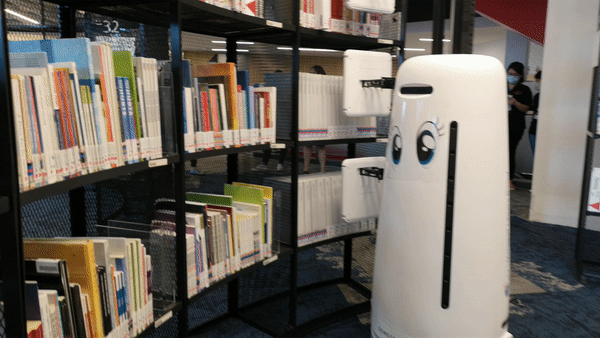
Tampines Regional Library deploys two Shelf-Reading Robots and both of them can complete scanning most of the library's collection in one night (yes, they only work at night).
The next morning, the system spits out a report, which provides the misplaced books and their location, allowing library staff to manually replace the books.
"So it's doing it every night, so we have very up-to-date records every day," says Library Manager Lee Yee Fuang.
This is very important not just for the library, but for patrons as well because then it is super easy to search for the location of a library book — right down to the shelf it is on — on the NLB app:
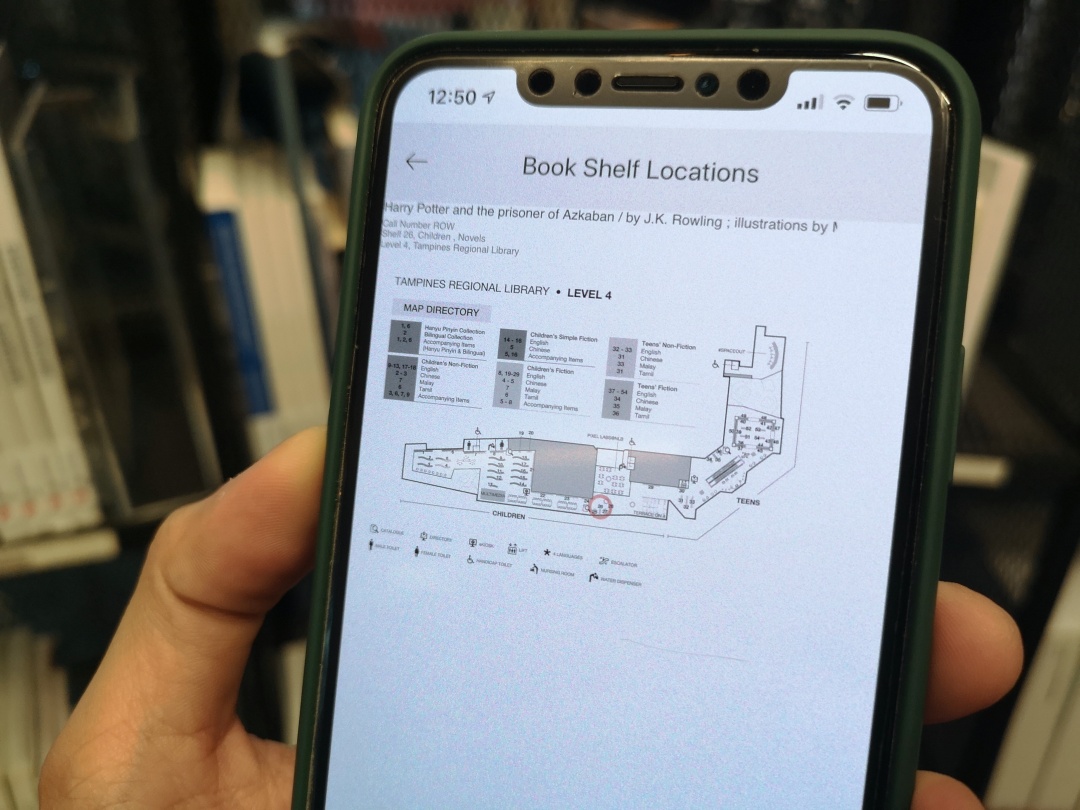 Bet you didn't know you can locate books using the NLB app. Image by Joshua Lee.
Bet you didn't know you can locate books using the NLB app. Image by Joshua Lee.
Mobile Bookdrops
Patrons of the Tampines Regional Library would be familiar with the next robot.
The library, which covers a total floor area of 10,900 square metres, has two entrances: The main entrance can be accessed from Tampines Avenue 4 while a secondary entrance is located along Tampines Avenue 5.
Many patrons prefer the secondary entrance because it is nearer to shopping facilities at Our Tampines Hub. However, the library's bookdrop is located at the main entrance — one entire football field length away.
Have you had to walk the entire length of a football field just to return a book? Neither have I, but apparently it is an exercise (haha) in frustration for many of the library's patrons.
Unfortunately, the National Library Board could not build another bookdrop at the secondary entrance because of space constraints.
Enter this marvellous chonk of a robot: The Mobile Bookdrop
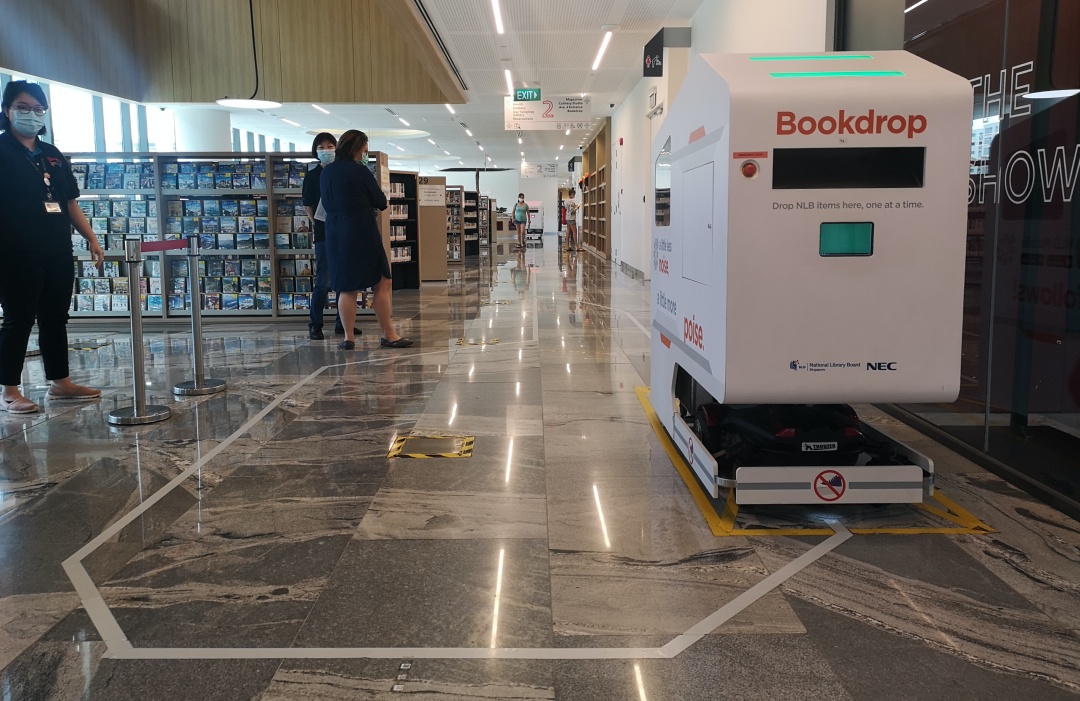 The Mobile Bookdrop was deployed to give Tampines Regional Library patrons more convenience and flexibility in returning books. Image by Joshua Lee.
The Mobile Bookdrop was deployed to give Tampines Regional Library patrons more convenience and flexibility in returning books. Image by Joshua Lee.
As its name suggests, this is a bookdrop that moves — specifically between the library's more popular entrance and its sorting area — giving patrons more convenience and flexibility in returning their books.
Tampines Regional Library deployed two mobile bookdrops in 2017 and it is the only branch to use this technology.
Unlike a conventional bookdrop, the mobile one can only hold up to 150 books.
Once it is filled, it displays a DO NOT RETURN message and starts its journey to the sorting area where it sends an alert to staff to replace the bin inside with an empty one.
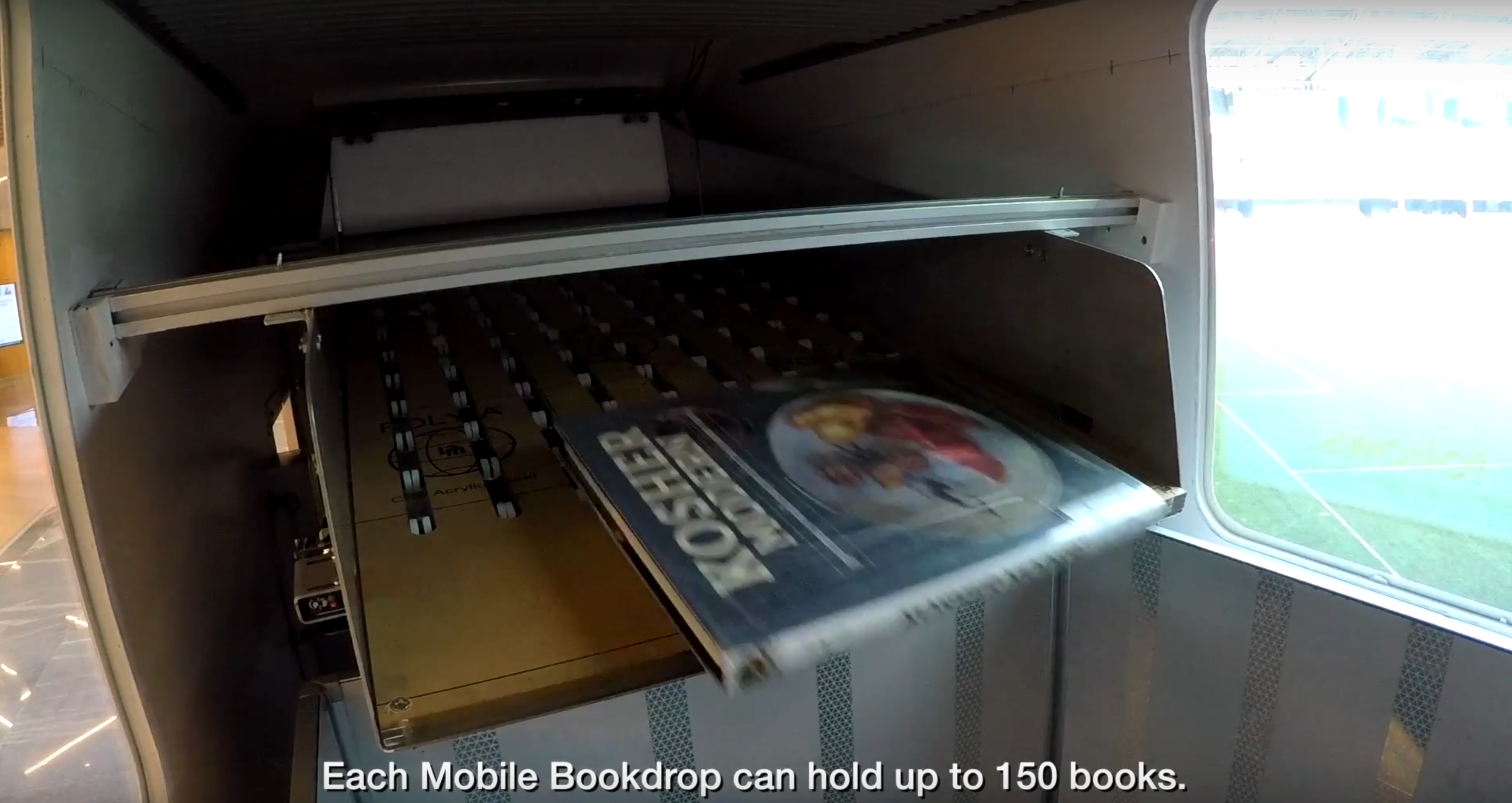 Screenshot via NLB YouTube video.
Screenshot via NLB YouTube video.
There isn't a little man manoeuvring the machine from the inside so the entire contraption, which only moves in one direction, is guided by a magnetic circuit on the ground.
If you look closely, you'll find that the circuit which the Mobile Bookdrop travels is punctuated by tiny inconspicuous QR codes. You can try scanning them, though it's unlikely they will lead anywhere.
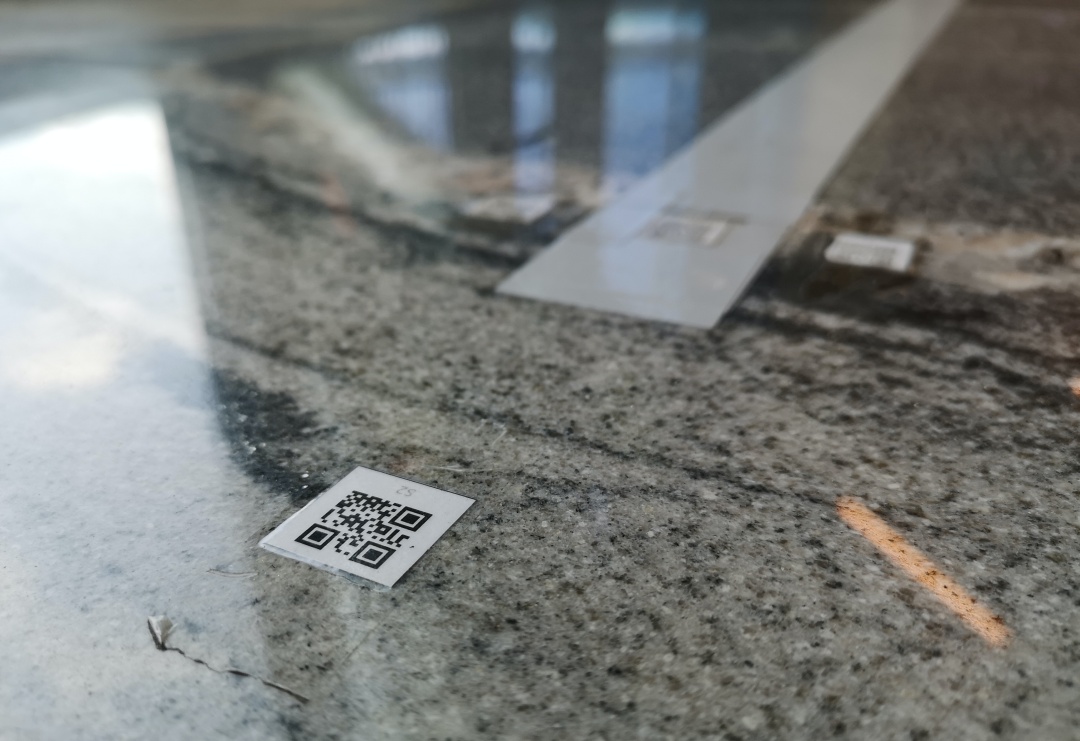 Tiny QR codes enable the Mobile Bookdrops to "communicate" with the system. Image by Joshua Lee.
Tiny QR codes enable the Mobile Bookdrops to "communicate" with the system. Image by Joshua Lee.
These QR codes track the robots' locations when they're on the move and enable the system to tell a robot to stay put whenever its counterpart is moving. This way, only one Mobile Bookdrop is moving at any one time.
The Mobile Bookdrops at Tampines Regional Library have been quite a hit with patrons, especially young kids, says Library Manager Lynn Koh.
"A lot of children love to return the items. Even if they come from [the main entrance], sometimes the children will walk all the way here just to use this robot."
The Auto-Sorter: A magical and hypnotic piece of technology
If you ever have a stressful day, may I recommend a trip to a library where you can see an Auto-Sorter in action?
It is strangely therapeutic.
The plonk down the bookdrop chute, the whir along the conveyor belt, that momentary pause as the Auto-Sorter system detects the RFID tag in the book, before it sends the book whizzing down to its rightful bin with a satisfying plop.
Beautiful.
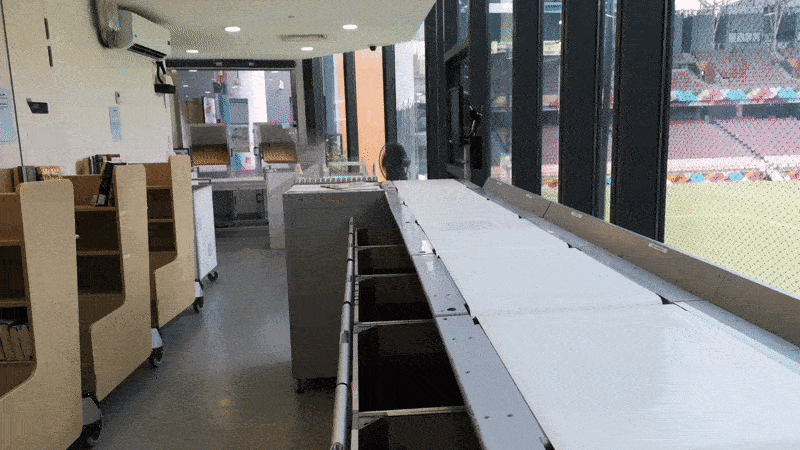
Various categories of books are grouped together to make the subsequent manual shelving easier for the librarians. For instance, this bin here has been programmed to receive books related to Computers, Business, Travel, and Recreation:
 Image by Joshua Lee.
Image by Joshua Lee.
Once the bins are filled — the system registers that it has reached a certain weight — library staff are alerted to transfer the books to these trolleys and subsequently wheel them off to be shelved.
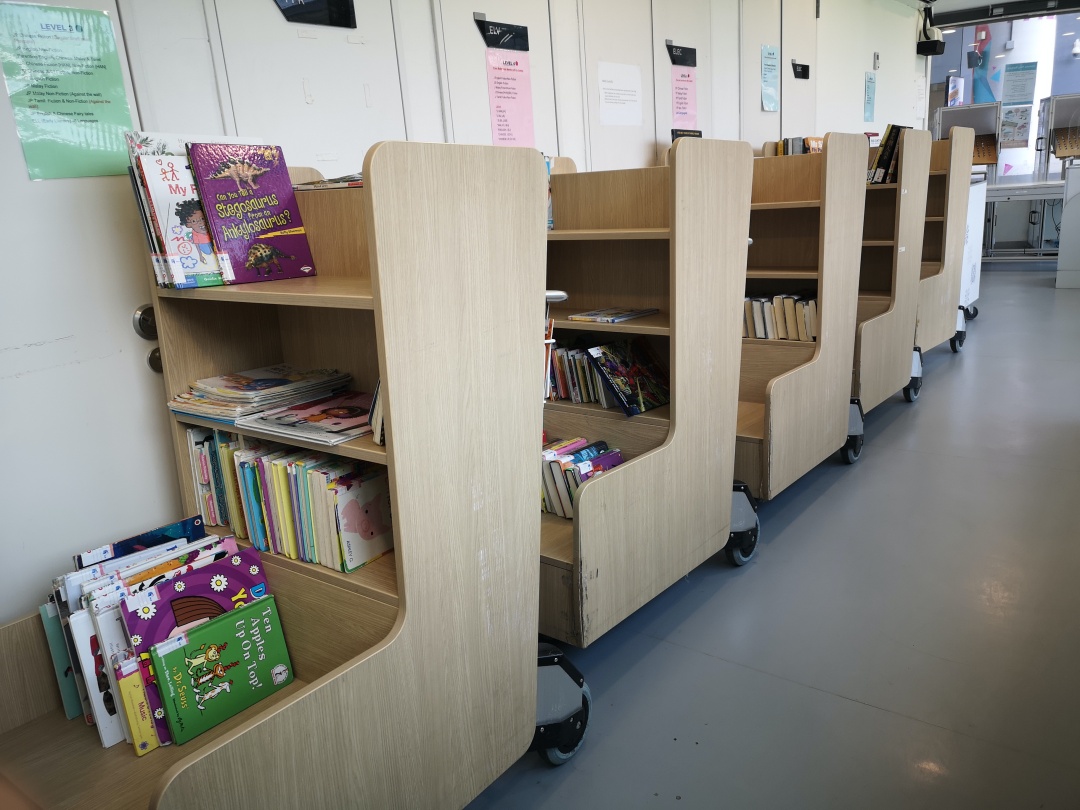 The books are then wheeled off to be manually shelved. Image by Joshua Lee.
The books are then wheeled off to be manually shelved. Image by Joshua Lee.
"Unfortunately we haven't reached the stage where these bins can go out automatically to shelve the books," Lee chuckles.
The Auto-Sorter was first piloted at library@chinatown. It was then deployed to 25 public libraries. Today, the Auto-Sorter is used at all public libraries except library@esplanade.
In fact, you can actually see the Auto-Sorter in action at the Bukit Panjang branch, the Bedok branch, library@harbourfront, and Central Lending Library.
Be warned, though — you might actually waste an entire afternoon just staring at this beautiful piece of technology work its magic.
Gives staff more time to conduct other activities
These automated technology are welcome changes, says Lee, adding that NLB is always looking for ways to improve its libraries' workflow and user experience.
As someone who has been visiting libraries from a young age, I can attest to how our local libraries have been transformed; they're no longer staid and musty places.
We are now able to access NLB's entire catalogue online, we can borrow books with our phones, and even loan e-books from the comfort of our homes (you don't even have to visit a library!).
But aside from these, the physical experience of bring in a library has now been vastly improved from the days of book stamping, manual sorting, and queuing up to collect reserved books (most public libraries even have reservation lockers now) — thanks to the robots and automated technology that NLB has embraced.
Technology — in the form of the Shelf-Reading Robot — is also supporting a workforce that is rapidly aging.
"Some of the feedback given [by older library staff] is that they can't even see the Dewey Decimal numbers on the book...They said they see until they get cross-eyed."
Thanks to this robot too, librarians have also received fewer queries on where certain books are located, simply because the books are in their rightful places and patrons can find them easily, says Library Manager Sharon Heng.
"So on the operations side, happy customers, happy staff!"
Now that technology has taken care of the "mundane and labour-intensive" aspects of a librarian's work, says Lee, they can focus their attention on other tasks.
Tasks like preparing the libraries in the morning, shelving books that were returned the night before, and most importantly, engaging patrons by recommending reads or library activities, says Heng.
"We are also a very social place. We do a lot of programmes...like author book talks, storytelling. All these things can't be done by robots."
"Reading is still at our core," says Lee. "I hope that we can do more reading, more recommendation [on what to read]. So if all the manual jobs can be assisted by robots, my staff can have more time to read, recommend books and connect with patrons."
We deliver more stories to you on LinkedIn
Stories of Us is a series about ordinary people in Singapore and the unique ways they’re living their lives. Be it breaking away from conventions, pursuing an atypical passion, or the struggles they are facing, these stories remind us both of our individual uniqueness and our collective humanity.
Top images by Joshua Lee.
If you like what you read, follow us on Facebook, Instagram, Twitter and Telegram to get the latest updates.
